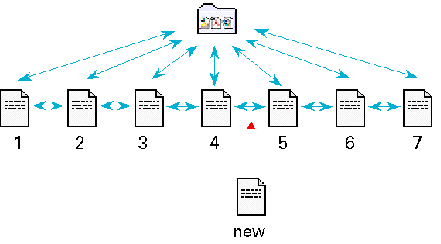|
| ||||||||||
|






There are five types of collections: Collection, Language Cluster, Sequence, Multi Cluster and Alternative Cluster.
ICONS
The icons used for these collection types are listed in the Icon Guide on page 2.
COLLECTION
Collections are used to hold documents and other collections.
LANGUAGE CLUSTER
A Language Cluster is a collection that functions as a multilingual document. If you insert two or more different texts into a cluster, each in a different language, the text that corresponds to the language the user has set will be displayed when the cluster is accessed.
SEQUENCE
A Sequence is a collection where, in addition to the collection listing, the system also generates Next and Previous links between the member elements. This means that users need not press the Back button on their browsers or select the next item manually when they want to look at all the elements one after the other. Sequences are useful in situations where a set of documents (pages) should be visited in a certain order, such as in many Web Based Training applications.

Figure 92 shows the logical structure of a sequence of 7 HTML documents. As an example of how easy it is to maintain such a structure on Hyperwave Information Server, consider the following scenario: We want to insert a new HTML document between documents 4 and 5 (see Figure 92). With a server that does not maintain links automatically (hyperlinks are statically stored within the HTML documents), we would have to perform the following operations:
b) document number 4 (Previous), and
c) (old) document number 5 (Next).
With Hyperwave Information Server, we would perform only one operation:
1. Insert document into sequence
This operation physically copies the document to the server, and inserts it into the sequence, taking into account the sort order defined for this sequence (e.g., "alphabetically by title of the document"). The rest (maintaining the link structure) is done automatically. In fact, it is not done at all on insertion, but the links are generated dynamically when users access the sequence or its elements. When you want to remove a document from a sequence, you just delete it. The navigation is adapted automatically.
Obviously, this reduces maintenance effort significantly. Additionally, the dynamic generation of hyperlinks between the elements enables a number of features not possible with static HTML:
If you insert documents into a sequence, then when a member of the sequence is accessed, buttons appear which let you navigate sequentially, forwards or backwards, through the members.
MULTICLUSTER
All documents that have been inserted into a MultiCluster are displayed as a composite document when the MultiCluster is accessed.
While both collections and sequences display a menu of the elements contained, the MultiCluster combines all its elements into one document and displays the result. As with other Hyperwave Information Server functions, this is done dynamically when a user accesses the MultiCluster, so that sort order, expiration time (see page 148), access permission, and user preferences are taken into account.
MultiClusters are useful in situations where you want to combine relatively small pieces of information (paragraphs, images, etc.) into one document. The individual pieces can be supplied by different authors (so that users can collaboratively create the large document without getting in each other's way), can have different access permissions (e.g. some paragraphs can only be seen by privileged users), and can be reused in other contexts.
EXAMPLE OF A MULTICLUSTER
Let us look at a simple example of a MultiCluster: a calendar of events:
Each event is a small document, either created by a customized entry dialog or an HTML editor. The "expiration date" attribute ( page 148) is set to the date of the event. The event listing is a MultiCluster, which is sorted by expiration date. This produces a single event listing sorted by date of the event. Listing of old events is automatically suppressed by the system (because expired objects are not displayed) without human intervention, so it looks as if the listing were maintained daily. Note that users with write access to the MultiCluster may add events, and edit or remove "their" events; there is no need to have a dedicated Webmaster to edit the event listing, or to grant all users write access to the whole listing.
ALTERNATIVECLUSTER
The AlternativeCluster is similar to the MultiCluster, but instead of returning a combination of all elements, the AlternativeCluster returns only one of its elements. An alternative cluster is a collection of documents from which exactly one document is chosen by certain criteria. The behavior of such a cluster is more like that of a simple document than a collection. The selection of this element is based on matching user preferences with attribute values of the elements.
Two typical applications for alternative clusters are
EXAMPLES
COMBINATIONS
All kinds of combinations of structural elements are possible (while some combinations are more useful than others). For example, an application might be built as a collection of sequences of MultiClusters of AlternativeClusters of documents. Figure 93shows another example.

Figure 93 also shows an important philosophical aspect of building applications with Hyperwave Information Server. The bold arrows represent "real", referential hyperlinks, which may of course be combined with structural elements. The goal is to replace the structural (organizational) hyperlinks by a combination of structural elements as much as possible, and use hyperlinks only for cross-references. This has the tremendous advantage that the system itself takes care of generation and maintenance of structural hyperlinks, with all the added benefits of dynamic link generation. It also means that the site can easily be restructured later, without editing any documents.






|